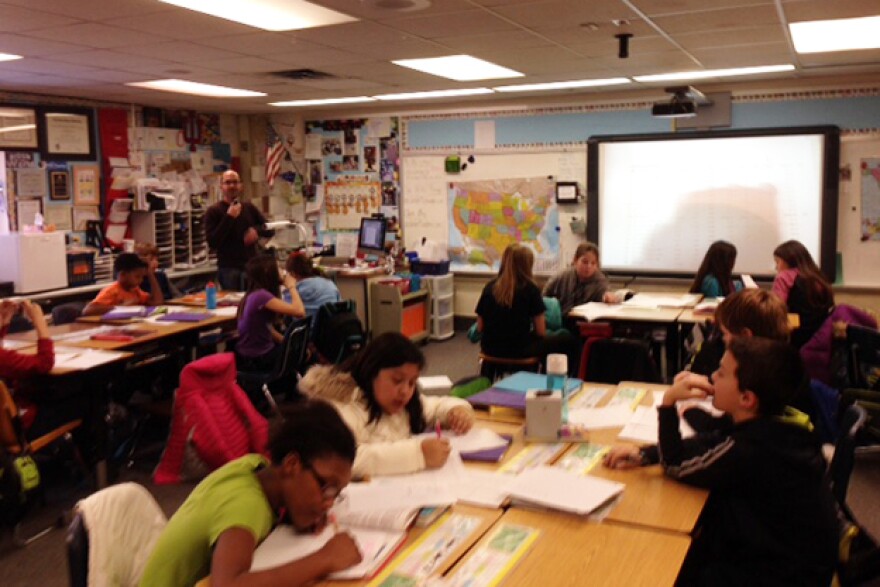President Obama is pushing for schools to increase their use of technology in the classroom. Teachers nationwide are introducing “Bring Your Own Device” policies, and beginning to use tools like Skype to bring in guest lecturers from around the world. Teachers in Indiana are being recognized for paving the way when it comes to new technology, but effectively incorporating it into teaching can be a challenge.
You can see the excitement on students’ faces in this fifth grade class at Allisonville Elementary in Indianapolis as their teacher Steve Auslander prepares to give them a math lesson using online software for NFL game stats. Auslander is excited too.
"I get really excited just talking about it," he says.
Auslander’s darting back and forth from his computer to a digital projector in the middle of his classroom, speaking to his students through a tiny microphone hanging on a string around his neck. And that’s not all he’s got in his arsenal.
Auslander throws out a lot of technology terms – and he recognizes that can frighten some people.
"It can be overwhelming. I understand why teachers might be nervous, oh my goodness, I am such a better teacher right now," he says. "The ability to connect with my students, just that alone is incredible."
Auslander is one of about 650 teachers in the Washington Township school district, under the leadership of Nikki Woodson. Woodson was one of eight Indiana superintendents recently recognized as leaders in their communities for incorporating technology into their classrooms.
Last week, President Obama welcomed Woodson and about 100 other superintendents from districts around the country to the White House. It was part of the president’s initiative to transform learning through technology.
"One of the things that we also need to do is yank our schools into the twenty-first century when it comes to technology and providing the tools and training that teachers need to use that technology to prepare all of our students for the competition that they’re going to face globally," she says.
Woodson says after her visit to Washington she realizes her district is lucky.
"We have a lot going for staff and students here in Washington Township, and that is not the case nationwide," says Woodson. "I think Indiana has been very forward-thinking when it comes to technology."
Plenty of school leaders agree digital learning is the way to go, but not every state has the resources to get up to speed. Districts can reallocate money from textbook fees or use federal funds such as Title I grant money, but that’s left up to the discretion of their local school boards and shifting money around can create funding gaps in other parts of the budget. .
According to “Keeping Pace” – a nationwide survey of digital learning across states, enrollments of students in fully online and blended schools throughout Indiana are up from last year, though.
In fact, researchers say Indiana has significantly expanded a variety of digital learning options for its students after state legislation established the state’s career council-- a group responsible for aligning the various participants in the education, job skills and career training systems.
"Having the students have an online experience is important for them. When they get to college they’re going to be taking online courses, and that’s what they’re going to be doing in the workforce."
That’s Ronda Eshleman. She’s the principal of Indiana Online Academy, a nonprofit program that offers supplemental online courses to students from more than 255 high schools throughout the state – including some schools in the Washington Township district.
Eshleman says having online skills is crucial in today’s global economy and at school is the best place to learn those skills.
"It’s a safe environment," she says. "You’ve got the teacher there…it’s kind of a nice way to get their feet wet, get them kind of used to it, because that’s the world they’re going to be living in."
But teachers often find it difficult to learn these new technologies. Steve Auslander says that’s why he often relies on his students – who he calls the “digital natives” – to help him figure things out.
"Let’s face it, a lot of our fifth graders know more about technology than even I do," he says. "They’re helping me kind of learn new things."
Eleven-year-old Danae Ingemi says class would be very different without their devices: she likes being able to use iPads, computers and other software to finish her schoolwork.
"We would just be like doing classwork on paper," she says, "and that would be like boring!"




